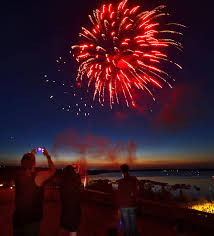Fireworks have always been one of my favorite parts of 4th of July celebrations. There are few things that rival watching the skies light up on a warm summer’s night. (Bonus points if the fireworks cap off a band concert!)
Fireworks, of course, have been around for a lot longer than we’ve been celebrating our country’s Independence Day. They are believed to have originated in China in the second century BC. Back then, state of the art technology was tossing bamboo stalks into a fire. When the hollow air pockets in the stalks heated up, the bamboo exploded. Fast forward a thousand years or so, and the Chinese discovered the earliest form of gunpowder. The gunpowder was packed into the bamboo stalks air pockets, and fireworks became a lot more exciting.
The notion of fireworks emigrated to Europe in the 13th century, where the Italians were the first nation to take them up, and by the 15th century fireworks were widely used in religious and other celebrations. Interestingly, the Italians are still associated with fireworks. Two of the world’s largest makers of fireworks – US-based Grucci and Zambelli – have roots in Italy, and were founded by Italian immigrants.
Over the years, fireworks displays have gotten more and more intricate, and sophisticated technology is often used:
Planning a professional fireworks show involves significant preparation, much of which is done using computers and simulation programs. Choreography software tools like Finale Fireworks or ShowSim allow designers to preview their creations without needing actual explosives. Interactive 3D perspectives enable creative developers to visualize the show from various audience viewpoints.
Before the advent of “e-match [electric igniters],” pyrotechnics were manually fired using switch panels. Now, however, script files can be exported to the firing system when after the show has been fully programmed, ensuring precise timing for each launch and explosion. This advancement leads to better and safer shows. (Source: EEPower)
Because of this, fireworks displays can showcase complex patterns, often using letters and numbers to spell out messages.
For all their beauty, there are a number of safety and environmental concerns involving fireworks. While professionally designed and operated shows have a good track record when it comes to safety, amateurs playing around with consumer fireworks (which are illegal in many states) end up with thousands of injuries in the US every year.
Then there are the environmental implications:
The launch of fireworks introduces various chemicals into the atmosphere, including oxidizers like perchlorates, which can contaminate water sources when they dissolve. Fireworks can create smoke and particulate matter, leading to poor air quality for hours after the display. Additionally, the metallic compounds and salts used to produce the colors in fireworks can harm both people and the environment.
Fireworks particles can be especially harmful to those with respiratory-related diseases such as asthma and COPD, and those with heart conditions.
Not surprisingly, fireworks – especially those of the amateur variety – have been known to start fires, so there can be an effect on air quality that goes beyond the original impacts the fireworks themselves cause.
Because of these concerns, many are looking for new ways to create aerial displays to help celebrate the 4th. Increasingly, electronics are used for light displays, which can run the gamut from lighting up buildings and monuments with red, white, and blue to “more elaborate displays, such as laser shows or choreographed light shows.”
Some cities are eliminating traditional fireworks displays in favor of drones:
Drone light shows are typically created using a fleet of drones equipped with LED lights. The drones are programmed to fly in formation and create specific patterns or images. The designs can be simple, such as a heart or a star, or more complex, such as a patriotic flag or a corporate logo. Drones can create messages in the sky by flying in formation and carrying lights, a newer technique that is becoming increasingly popular.
Then there’s augmented reality.
Augmented reality fireworks aren’t physical fireworks. They are images projected onto a digital device. AR fireworks can be used to create a variety of effects, like making it appear as if fireworks are exploding in the sky overhead or shooting out of your hands.
I’m not that wild about the idea of AR fireworks. For all their faults, traditional fireworks displays bring communities together. AR fireworks apps – which had their moment during the pandemic – are an individual experience. Personally, I’d rather hear the crowd oohing and aahing as together we enjoy the same display – even if it’s a laser or drone show. (Just as long as we don’t revert to hollow bamboo stalks tossed in the fire.)
Anyway, however you celebrate it, wishing all our US readers a Glorious Fourth of July.
Source of Image: Syracuse.com
